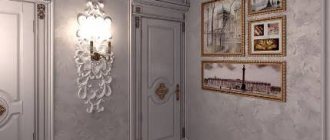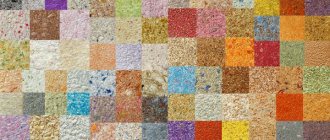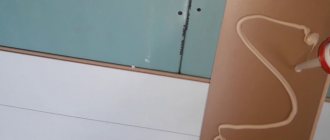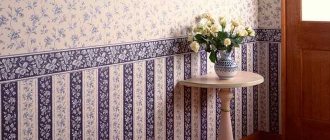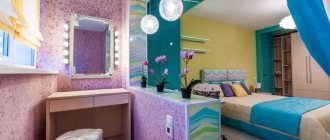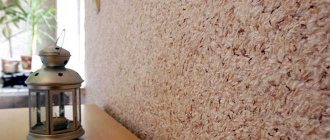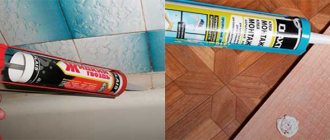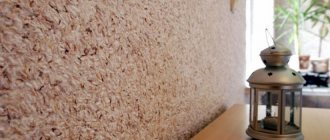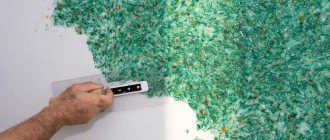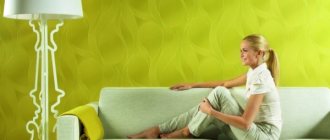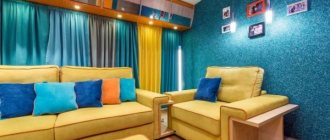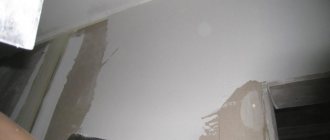Wallpaper is a facing building material for finishing the interior surfaces of premises (walls, ceilings), produced in the form of canvases rolled into rolls. Their main function is decorative. Wallpaper got its modern name from the word “upholster”; the first ones were made of fabric; staples were used to attach them, thereby upholstering the walls. Over time, paper ones appeared, which were already used to paste over surfaces.
Modern technologies make it possible to produce wallpaper based on paper, non-woven fabric, vinyl, different textures (glass wallpaper), from various materials, such as bamboo, cork, stone. Liquid wallpaper has become very popular in Europe and here.
Liquid wallpaper
Liquid wallpaper is a decorative finishing material that has the properties of ordinary wallpaper, plaster and painting materials. It appeared on the market quite recently, but has gained popularity due to its wear-resistant properties , ease of use, and the ability to be used for finishing hard-to-reach surfaces and difficult areas (columns, arches, niches). They are similar to decorative plaster, but they are different materials that differ in composition.
Both materials are sold not in rolls, like regular wallpaper, but in bags with a dry mixture. To use, the mixture is diluted with water and applied to the surface using a spatula. But the main difference is that the components of any plaster are sand and cement, but liquid wallpaper does not have these components. Includes:
- Fiber fillers (silk, cellulose, cotton)
- Adhesive substance.
- Acrylic dyes.
- Decorative fillers (glitter, mica, crumbs from mineral and natural components).
Based on the composition of the incoming fibers, they can be divided into several types:
- Silk.
- Cotton.
- Cellulose.
- Mixed type (silk+cellulose, cotton+silk).
According to the method of use there are:
- For professional use , the mixture is produced in white color; to work, you need to add dye and decorative components. Finishing requires certain knowledge and skills of special finishing craftsmen.
- For independent use - wallpaper is sold ready-to-use, containing all components. The use of this finishing material does not require special skill; repair work can be done independently. To work, the finished mixture is diluted with water in the proportions specified in the manufacturer's instructions. The mass is then left to swell for about 12 hours. Application is carried out using a spatula, roller, grater or Hopper gun.
Liquid wallpaper is a modern finishing material and has a number of advantages:
- Plasticity - the ability to smooth out surface defects, obtain a smooth surface without seams or joints,
- Air permeability - surfaces “breathe”, which eliminates the appearance of mold,
- A variety of design solutions - you can choose not only color, texture, but also apply drawings using special stencils,
- Ease of replacing individual sections - a section that has become unusable is moistened with water, cut out with a knife, the surface is primed, a new layer is applied,
- Increasing the heat and sound insulation properties of the room.
Economic component when choosing
The cheapest option is, of course, paper wallpaper, but you should understand the following: in order for paper wallpaper to look beautiful, you need to level the walls by applying plaster to them. Therefore, the price of the issue increases.
Non-woven and vinyl wallpapers are more expensive, but a significant part of the wall defects under them will be invisible, so you may save on plaster.
Liquid wallpaper is quite capricious, so you need to properly prepare the walls for it and give it a white color. The cost of liquid wallpaper is not small.
Good decorative plaster is more expensive than most wallpaper, but for this money you get durable, practically indestructible walls. However, some expensive wallpaper will cost you more than plaster. Work on applying decorative plaster also costs more than when wallpapering.
Regular wallpaper
Ordinary wallpaper is a finishing building material in the form of rolls on different bases, used for decorative decoration of ceilings and walls of residential and office premises. Based on the material from which they are made, wallpaper can be divided into types:
- Paper ones are the most budget option, they last from 3 to 5 years, the base is paper, in one, two or three layers. They vary in density, can be with a loose surface, embossed, or waterproof.
- Non-woven - the basis is a fabric of cellulose fibers or a mixture of natural cellulose fibers with chemical fibers (polyester). They can be regular or paintable, smooth, with an embossed pattern. They have good elasticity, do not shrink, and do not swell from glue and water. But there is a drawback - they do not allow air to pass through.
- Vinyl - the base of this material is paper or non-woven, but another layer is added - polyvinyl chloride (vinyl). This technology makes the wallpaper durable, resistant to moisture and fading; it can be used in the kitchen, bathroom, hallway, and can be washed with a brush when dirty. The design on them can be applied by hot stamping (silk-screen printing) or chemically (using inhibitors).
- Fabric - a textile layer of cotton, linen, silk is added to the usual base (paper, non-woven fabric). The main advantage of the coating is breathability, but it is afraid of light and moisture, cleaning is only possible using a dry method. The material is very beautiful in its texture, but quite expensive.
- Fiberglass wallpaper is a finishing material made of glass woven fabric with a textured pattern (rhombus, herringbone, parquet), intended for painting only. They have a number of advantages over other types - high strength, the ability to be repainted many times, insusceptibility to moisture, service life - about 20 years.
This is not the entire list of wallpaper types; they come in bamboo, wood, metal, leather, and stone. The name directly depends on the components that make up the building material.
During operation, there is a need to clean it from dirt, so wallpaper can be divided into groups marked with different graphic symbols:
- Dry cleaning - can be cleaned with a vacuum cleaner, sponge, or soft brush.
- Wet cleaning - you can use a damp sponge or brush.
- Washable - it is permissible to use wet brushes and sponges with a fragmentary application of detergents.
- Super washable - can be cleaned with detergents, sponges and brushes, without the risk of damaging the surface.
What you need to know when buying wallpaper
- Most rolls have two types of sizes: width 0.53x10.05 m and 1.06x10.06 m. Their packaging usually indicates how much area we will cover when choosing this product.
- If the wallpaper pattern is large and not too dense, be sure to leave a margin of about 15% because you will have to trim it to suit the theme. However, when it is small or absent, a 5% margin is sufficient.
- When measuring a room, keep door and window openings in mind. They can both save the amount of wallpaper and also entail additional costs (don’t forget about the folds in the door and window openings).
- The same wallpaper from different batches may differ slightly from each other. When purchasing wallpaper, buy rolls from the same batch.
- Paintable wallpaper can have a raised pattern, which can be given the chosen shade using paint.
What is the difference?
Maintainability:
- Regular wallpaper is more difficult to replace; traces of joints and seams will remain, and the pattern may need to be adjusted.
- Liquid ones are easier to restore; no special skill is required; the patch will not stand out against the background of the main surface.
Economical:
- Repairing simple wallpaper will leave scraps and glue residue.
- Liquid ones have no waste, the composition is diluted as it is consumed, leaving a dry mixture that can be easily stored or used for restoration in the future.
Environmental friendliness and safety:
- The composition of rolled webs may include artificial components and fillers.
- Liquid wallpaper consists of natural, non-toxic ingredients and does not cause allergies.
Quality of pasted surfaces:
- Canvases of ordinary wallpaper can be glued to different surfaces, smooth and not very smooth.
- In the case of liquid materials, surface roughness is required; it will flow from smooth walls.
Design of various decorative elements:
- Rolled fabric is not convenient for gluing ledges, niches, arches; it is impossible to decorate volumetric fragments, for example, stucco molding.
- Liquid building material can be used to easily finish hard-to-reach areas and implement complex design solutions.
Elasticity:
- When a new home shrinks and walls move seasonally, regular wallpaper may crack.
- The plasticity of the liquid material does not cause cracks or tears when houses move.
Hygroscopicity:
- There are types of roll wallpaper that are moisture resistant and can be washed.
- Liquids cannot be used in rooms such as a bathroom; they absorb moisture.
Which is easier to apply?
To obtain a high-quality surface using decorative plaster, you will have to invite a specialist, since this work is beyond the power of beginners. The plastering process consists of several points:
- dismantling the old coating and priming the base;
- preparation of solution;
- uniform distribution of the mixture over the surface;
- formation of structure using relief rollers;
- smoothing the surface with a grater;
- grinding;
- applying dye.
Liquid wallpaper, from the point of view of work, is simpler and more profitable; the process can be mastered even by a novice finisher. The following actions must be taken:
- dismantle the old coating and eliminate major defects;
- prime the surface;
- prepare the mixture;
- apply the prepared solution to the base using a spatula;
- After drying, painting is done.
Application
Based on the above comparisons of two building materials, we can conclude:
- It is easier to decorate simple rooms with regular wallpaper, but for complex decorative solutions it is better to use liquid wallpaper.
- In terms of thermal insulation properties, liquid wallpaper is clearly the leader, so if you need to insulate a room, then preference should be given to this material rather than roll wallpaper.
- In a room with temperature changes, in order to avoid the formation of mold, it is better to use liquid wallpaper; not all ordinary wallpapers have the ability to “breathe”.
- To obtain unique patterns, liquid finishing material gives room for imagination; rolled fabric allows you to get only a standard look for the room.
Source: vchemraznica.ru
Reviews
Svetlana, 28 years old, Moscow
During the renovation, both liquid wallpaper and textured plaster were used. The first material was used inside the house, and the second was used to decorate the facade. These materials are difficult to compare. The wallpaper is lighter and the mixture cooks faster. Having no experience in carrying out such work, I managed to create a smooth and beautiful coating. With plaster it is more difficult. The result is satisfactory, but there are still some minor defects. It is better to hire a professional to work with plaster.
Irina, 38 years old, Vladivostok
We spent about 4 years renovating the apartment and used both finishing materials. Builders were hired to carry out the work. The surfaces covered with plaster have retained their original appearance, but the wallpaper already has defects.
What is liquid wallpaper and what are its features
Liquid wallpaper is a material for finishing walls, something between paper wallpaper and decorative plaster. Although the name of this finishing material contains the word “wallpaper,” you won’t see the usual rolls, since in its original state it is a dry, granular substance that you have to dilute with water. Liquid wallpaper differs from Venetian plaster, with which many people unknowingly confuse it, by the absence of large sand fractions, the presence of cellulose fibers, and a thin layer of application.
In addition to cellulose, which we have already mentioned, the composition of liquid wallpaper includes cotton or silk fibers, adhesives (usually carboxymethylcellulose), water-dispersed dyes, fungicides that protect natural fibers from fungi and mold, thickeners and plasticizers, as well as components that change decorative properties of the coating (mineral particles of different fractions, small polymer beads, mica grains, wool fibers, dry algae, etc.).
conclusions
The question “what to choose from the two types of finishes?” always solved differently. For some, the decisive factor will be a burning desire to try out new material, regardless of the other pros and cons.
For those for whom time is precious, it is easier to lean in favor of liquid wallpaper. But those who definitely want to have an elite finish will prefer the classic plaster version.
Understanding that these two materials are not the same thing, when deciding what is more suitable - decorative plaster or liquid wallpaper - you will be able to consider and compare them according to several parameters. In addition, nothing will prevent you from decorating the premises with different types of finishes, and comparing them from your own experience.
The advantages of liquid wallpaper
Why do we need another decorative finishing material with such a variety of existing ones? When you find out how many advantages liquid wallpaper has, this question will disappear on its own.
Easy to apply
Covering walls with liquid wallpaper is not a particularly complicated process. You will not be required to be super qualified. Moreover, you can cope with this work even without an assistant. All you have to do is prepare a working solution from the dry mixture and water, and then apply the resulting plastic mass to the wall and smooth it with a spatula. Agree, this is much easier than cutting the rolls, lubricating the resulting strips with glue, sculpting them on the wall with a partner, aligning and adjusting the pattern, “dispersing” the bubbles and smoothing out the wrinkles. Admit it, it’s unlikely that you’ve ever managed to stick up roll wallpaper without swearing every minute.
Draft resistance
To prevent regular paper wallpaper from coming away from the wall in the first 24 hours after gluing, it is necessary to tightly close all the windows in the house. But being in an unventilated room where renovation work is actively underway can sometimes be very difficult. By choosing liquid wallpaper, you will save yourself from this problem. They are not afraid of drafts! Moreover, ventilating the room will benefit the material applied to the wall, as it will speed up the drying process.
Seamless coating
Unlike roll wallpaper, liquid wallpaper covers the wall with a monolithic layer, without seams or joints. This coating not only looks more aesthetically pleasing, but also retains its original appearance longer, since it is more durable.
Ecological cleanliness
Liquid wallpaper does not contain any synthetic additives; all components are exclusively natural. As a result, this material is very environmentally friendly. During its operation, no substances harmful to health are released. The coating has no odor, and it also does not absorb foreign odors from the outside. In addition, liquid wallpaper, being a “breathable” material, does not create a greenhouse effect and ensures the maintenance of a comfortable microclimate in the room. The environmental friendliness of liquid wallpaper is one of its biggest advantages when choosing a finishing material for a children's room.
Application on curved surfaces
Liquid wallpaper is perfect for curved surfaces - decorative arches, columns and other shaped interior elements. Surface unevenness is not a problem for those working with this material, except that the application speed is slightly reduced.
Plastic
Unlike many other finishing materials, liquid wallpaper, which has good plasticity, does not crack or move away from the wall when the house shrinks. This feature of the material will be appreciated by apartment owners in new buildings.
Antistatic
Due to the absence of synthetic additives in liquid wallpaper, they are antistatic, which means they do not attract dust.
High noise absorption
Liquid wallpaper, due to its porous structure, is able to absorb noise. Of course, they cannot guarantee ideal silence, but they are quite capable of reducing the level of extraneous noise by 10-15%. In addition, they prevent echoes in the room.
Frost resistance
Due to its structure, liquid wallpaper has significant frost resistance. This property of the material contributes to a significant expansion of the scope of its application: liquid wallpaper can be applied even on non-insulated (but glazed!) loggias.
Thermal insulation
The fine-porous structure of liquid wallpaper provides the thermal insulation properties of this decorative material. However, you should not hope that liquid wallpaper will significantly reduce the thermal conductivity of the walls. Taking into account the fact that the thickness of their application rarely exceeds 2-3 mm, they can only serve as an addition to more effective thermal insulators. But, we have to admit, when liquid wallpaper is applied to a concrete wall, it becomes warmer to the touch.
Fire safety
Unlike vinyl or non-woven wallpaper, oil-based paint, plastic wall panels and many other decorative materials for wall decoration, liquid wallpaper does not support combustion and does not emit hazardous chemicals when exposed to high temperatures. Often fire retardants are additionally added to liquid wallpaper.
Maintainability
Sooner or later, traces of use appear on the wallpaper - tears, scratches, abrasions. Particularly affected are areas near sockets and switches, and walls in the hallway. Unlike ordinary rolled wallpaper, paper or non-woven, liquid wallpaper can be repaired in fragments. It is enough just to soak the material on the damaged area, remove the layer of liquid wallpaper and make a “patch”. After drying, its color will be equal to the main background, and the repair site will not be noticeable. In case of minor defects, you can not even make a patch, but carefully rub the soaked material on the wall. This property of liquid wallpaper will certainly be highly appreciated by pet owners and parents of small children.
Color fastness
Liquid wallpaper, especially those containing silk fiber, are characterized by increased resistance to ultraviolet radiation: they do not fade when exposed to sunlight, maintaining the original brightness and richness of colors for many years.
A large assortment
The rich color palette of liquid wallpapers available for sale today allows them to be used in rooms decorated in almost any style. In the catalogs of leading manufacturers you can find up to 2-3 hundred available colors - from calm pastels and office-restrained to bright and rich.
However, many consumers prefer to purchase a semi-finished product - the so-called “base”, which can be tinted independently, choosing the shade and color saturation to suit your taste. Often, not only dye is added to the base, but also various decorative components, ultimately obtaining a coating that is unique in its color scheme and relief. If desired, you can create a real panel on the wall using liquid wallpaper with its own texture and color in different areas.
Main differences between materials
The main differences between the materials are as follows:
- in the method of application;
- maintainability - liquid wallpaper is easier to repair; if necessary, individual damaged areas can be replaced without damaging the appearance;
- with the help of liquid wallpaper you can finish surfaces of any shape in the most inaccessible places, unlike roll materials;
- Liquid wallpaper is elastic, unlike roll materials, which is important when the building settles after finishing work.
Cons of liquid wallpaper
Why, with such a huge number of advantages, liquid wallpaper has not become a leader in the market of materials for decorative wall decoration? Firstly, this is still a relatively new material, and the consumer does not have confidence in it based on their own experience. Secondly, along with the undoubted advantages of liquid wallpaper, there are also a number of disadvantages, which may be significant for some potential users.
Price
Liquid wallpaper is not the cheapest material among those used for decorative wall decoration. However, it should be recognized that over the years the market situation is gradually changing. An increase in sales of this material, as well as the establishment of its production at domestic factories, leads to a gradual decrease in cost: today liquid wallpaper can be purchased even at a price of 100-120 rubles per square meter.
To be fair, it is worth noting that applying liquid wallpaper does not require prior perfect alignment of the walls. Excluding this expensive procedure from the list of mandatory ones leads to a reduction in the cost of work. As a result, in terms of the cost of the final result, liquid wallpaper can in some cases be equal to conventional wallpaper.
Difficulty in calculating material consumption
It can be quite difficult to estimate the amount of material you will need, and therefore the final cost of finishing, when using liquid wallpaper. The figure greatly depends on both the quality of the base and the application technique. Material consumption increases in the presence of all kinds of holes, cracks and other irregularities in the wall, as well as when applied to curved surfaces (columns, arches, etc.). But even on smooth walls, applying a layer of the recommended thickness is not an easy task. Not every novice master can do this - here, as they say, you need to get better at it.
Drying time
After application to the wall, liquid wallpaper requires 2-4 days to dry completely, depending on the temperature and humidity in the room. This leads to an increase in the total duration of finishing work. However, in some cases this disadvantage of liquid wallpaper can be considered as an advantage. Those who do not have much experience in applying such material will have enough time to correct flaws that were not immediately noticed.
Vulnerable to stains
If you do not pay due attention to the process of preparing the base, for example, use unsuitable materials, do not even out the color of the base, do not remove the old coating (wallpaper, paint, whitewash) and existing metal fasteners, over time stains may appear on the decorative coating, which will greatly damage the appearance type of finishing. The source of contamination can be the material of the wall and the material of its rough finishing.
Sensitivity to moisture
Liquid wallpaper is not intended for rooms with high humidity, and this is their main disadvantage. This is not even a drawback, but simply a feature of the material that needs to be taken into account at the stage of deciding on the type of finish to be used. If you still decide to use liquid wallpaper to decorate the walls in the bathroom or kitchen, at least skip surfaces that are in direct contact with water. You can, of course, treat the applied coating with water-repellent agents, but in this case it will lose many of its valuable properties - vapor permeability, resistance to cracks, maintainability.
When preparing walls for liquid wallpaper, it is imperative to use a moisture-proof primer. If you neglect this recommendation, extraneous stains may appear on the surface of the decorative finish over time.
In addition, a consequence of the increased sensitivity of liquid wallpaper to moisture is the only available method of caring for the finished coating - dry cleaning.
Source: srbu.ru
Results: comparison table
To make it easier to navigate the features and characteristics of different types of wallpaper when renovating an apartment, you can use the table presented.
| Type of wallpaper | Environmental friendliness | Mechanical strength | Hygroscopicity | Ease of use |
| Liquid | + | + | — | — |
| Natural | + | — | + | — |
| Fiberglass | + | + | — | — |
| Fabric | + | — | + | — |
| Paper | + | — | + | + |
| Vinyl | — | + | — | + |
| Non-woven | — | +/- (depending on base) | — | + |
| Metal | +/- (depending on base) | — | +/- (depending on base) | + |
Tyutyunnikov Dmitry
Article verified by a decorative finishing specialist
Advantages and disadvantages of liquid wallpaper
Due to a number of distinctive features from similar finishing materials, liquid wallpaper is used for finishing ceilings, walls, columns and other architectural structures in residential and office premises.
Advantages:
- wide choice of textures and colors;
- environmental friendliness - exclusively natural materials are used for the manufacture of wallpaper, which indicates safety to health due to their use in interior decoration;
- vapor permeability due to the fibrous structure of the finishing material helps regulate the indoor microclimate;
- the antistatic properties inherent in the wallpaper due to the use in the manufacture of natural components that have a neutral electrical charge prevent the accumulation of dust on the wallpaper;
- elasticity - prevents damage to the decorative layer during the shrinkage of the new building;
- excellent heat and sound insulation are characterized by porosity of the structure;
- frost resistance - allows you to decorate walls and ceilings inside periodically heated rooms, since freezing of the walls does not affect the appearance of the finish;
- high resistance to sudden temperature fluctuations and drafts;
- excellent camouflage of minor cracks and defects;
- ease of application, since there is no need to combine the pattern, carefully measure and adjust the sizes of individual parts;
- absence of joints on any surface;
- ease of finishing of complex architectural elements, as well as hard-to-reach places near sockets and switches;
- the ability to replace only the damaged area of the decor;
- economical, since the material can be used repeatedly;
- service life reaching 10-12 years.
Flaws:
- the impossibility of wet cleaning, since with prolonged interaction with water the wallpaper softens, as a result of which the integrity of the finish is compromised;
- the time for complete drying of wallpaper with a minimum application thickness of 1-2 mm reaches 3 days, and with a layer thickness of 10 mm it increases to 5-6 days;
- high cost compared to roll wallpaper.
Despite the presence of shortcomings, liquid wallpaper is in quite high demand. In addition, indoor ceilings and walls decorated with liquid wallpaper do not require labor-intensive maintenance, since to maintain cleanliness it is enough to periodically vacuum them and remove small dirt with a regular eraser. However, all these advantages and disadvantages are characteristic only of high-quality liquid wallpaper.
Painting the walls
Tips for choosing paint for kitchen walls:
- Choose an acrylic-based composition. This paint is medium thick, easy to apply and dries quickly. Forms a glossy finish that is easy to clean.
- The paint chosen for the kitchen must withstand temperature changes and exposure to steam well. If the walls have defects, choose matte compounds.
- The color and structure of the paint should match the interior of the kitchen.
Advantages of paint:
- easy to apply;
- you can mix colors;
- You can cover the walls with a new layer.
There is only one minus - if you do not prepare a rough coating for the walls, after painting all the defects will be visible on them.
Criteria for choosing liquid wallpaper
The choice of a particular product is always associated with some nuances, knowledge of which allows you to avoid significant mistakes. When purchasing liquid wallpaper, you should consider the following information.
Wallpaper type
Liquid wallpaper is supplied to the market in the form of a mixture, including:
- cotton or silk threads of artificial or natural production;
- cellulose, previously dissolved into individual fibers;
- natural dyes;
- fungicides of natural origin;
- adhesive material.
In addition, to give the wallpaper a more impressive look, some models add various decorative elements in the form of sparkles, gold or silver threads, mica, wood bark chips, dry seaweed and other similar materials.
Based on the predominant components, wallpaper is divided into the following types:
- silk wallpaper - characterized by high resistance to ultraviolet rays, long service life without any changes to the original appearance and high decorative qualities;
- cellulose wallpaper - characterized by a predominance of colored cellulose fibers, due to which they fade faster under the influence of ultraviolet radiation and are less durable. The decorative properties of this type of wallpaper are also low, as evidenced by the fairly low cost of the material;
- combined or cellulose-silk wallpapers represent a cross between the previous types in terms of price and quality.
Today, liquid wallpaper can be purchased either in a ready-made version or as a dry mixture, which, before applying to the surface, must be diluted with water to a porridge-like consistency, according to the instructions on the package. After complete drying, the walls, as well as other interior elements decorated with liquid wallpaper, acquire a rough surface that is pleasant to the touch.
Thus, silk wallpaper has better performance characteristics compared to cellulose or cellulose-silk finishing materials, but the cost of such wallpaper remains at a fairly high level.
Color
When choosing the shade of liquid wallpaper, you need to focus on the purpose, area, and layout of the room. So, for office premises, it is better to give the greatest preference to plain cold or warm tones of the color palette.
For residential premises, the future interior design plays a decisive role. If you plan to install a large amount of furniture in the room, which needs to be emphasized, then it is better to choose wallpaper in discreet shades. If the room is quite spacious with a minimal set of furniture, then bright wallpaper will come in very handy.
Of course, the decisive factor when choosing the shade of liquid wallpaper from the huge variety of proposed options is your own idea of a particular color in the future interior. However, a well-chosen color scheme will give the room the necessary comfort combined with luxury and originality.
Price
The range of price factors for various names and types of wallpaper is quite wide. In most cases, the cost of a well-known manufacturer's brand indicates the quality of the material, since it is formed under the influence of the type and quality of the components used to make a certain type of wallpaper.
If the price of liquid wallpaper seems very low, then you should refuse to purchase such material. It is quite possible that the formulation of the composition was violated during manufacturing, which in the near future will affect the performance characteristics of the finish.
The most expensive and high-quality wallpaper today is French-made. Turkish and Russian wallpapers are slightly inferior both in price and in performance characteristics.
Manufacturer
The manufacturer plays an important role in the quality of the chosen material, as well as the finished look of the decor. Currently, not only foreign, but also domestic manufacturers are engaged in the production of liquid wallpaper. Well proven:
- Senideco wallpaper made in France. Liquid silk wallpaper is available in more than 150 shades and is sold as a ready-made dry mixture;
- Cotex cotton wallpaper, produced in France, is sold not as a ready-made mixture, but as separate components. This allows the buyer to independently select the required shade, as well as the adhesive base;
- Silkcoat liquid wallpaper, produced in Turkey, has a lower cost, while not being inferior to French wallpaper in any quality characteristics;
- Turkish wallpaper based on silk fibers under the Bayramix koza brand differs from previous versions by the presence of acrylic in its composition, which acts as a binding element. This fact prevents the application of wallpaper on an oil-based surface in order to avoid the appearance of yellow spots on the decorative finish over time. In this regard, a new type of liquid wallpaper was developed (photo below) with a waterproofing effect, based on water-based components;
- Plaster is a Russian-made liquid wallpaper that has excellent performance properties that are as close as possible to wallpaper from French manufacturers. At the same time, the material is several times cheaper than from Turkish or French manufacturers. Currently, silk plaster liquid wallpaper is popular in the CIS countries, Europe, and the Middle East. Silk plaster products are constantly being improved, new shades of the color palette are added, thereby expanding the boundaries of design solutions. In addition, when decorating a room, you can combine liquid wallpaper, the colors of which are represented by various collection series, thereby creating bright and eye-catching designs.
Thus, the best foreign manufacturer of liquid wallpaper is Senideco, one of the first to introduce this unique finishing material to the world. Among domestic manufacturers, the undisputed place belongs to wallpaper of the silk plaster brand. A large selection of liquid wallpaper - Leroy, which presents diverse collections from various manufacturers. However, Russian-made wallpaper will cost much less than its foreign counterparts.
Source: stroiremdoma.ru
What do they look like in the interior?
Liquid wallpaper can be applied to walls in any premises (residential and office). They are able to hide surface defects, and therefore can replace a layer of finishing plaster. The main task is to give the walls the desired appearance to create the intended interior. In an apartment, wallpaper is quite appropriate in the living room, bedroom, hallway, bathroom, kitchen and loggia. With their help, various decorative effects are provided. This can be achieved in several ways - painting in different colors, forming designs and patterns, giving a relief to the surface, applying in stripes with a change in direction. Which method to choose depends on the type of room and design style.
Look at the video, a selection of pictures of the interior of rooms with liquid wallpaper on the wall.
Colors
When finished, liquid wallpaper immediately has a certain color. In this case, the desired option is selected taking into account the overall design style. To give any shade, the appropriate pigment is added to the mixture when mixed with water. In the classic style, preference is given to light, warm tones. In modern design, color contrast is widely used, when different walls can have different shades.
Liquid wallpaper of heavenly color
Rich shade in the living room
White wallpaper is usually used for painting. After hardening, paint of the desired color is applied to them. The following colorful compositions are most suitable:
- Water-based paint. It is suitable for dry rooms and is the cheapest option. The paint is diluted with water to a convenient consistency, and the desired color is achieved by adding dye.
- Acrylic paints. This is the most common material that has sufficient moisture resistance and abrasion resistance.
- Latex paints. They are used to decorate rooms with high humidity. Wallpaper with this coating can be washed using ordinary detergents.
- Silicone paints. This is one of the most expensive options, but the coating has improved performance properties and greater durability.
Leaf IMPORTANT! Painting liquid wallpaper is carried out using a roller or spray gun. In hard-to-reach places, use a brush of different widths
Before painting, it is recommended to coat the surface with a strengthening primer, which will improve the adhesion of materials.
Drawings
One of the most effective ways to decorate walls is to apply drawings, patterns, and ornaments to the surface. In the case of liquid wallpaper, 2 methods are used: applying a pattern by painting a hardened layer (art painting) or forming a pattern with the composition of the liquid wallpaper itself using stencils.
Original drawing in the interiorWhen painting artistically, paint is applied in the following ways:
- painting with a brush;
- drawing a picture using a stencil;
- not applying the ornament using a relief roller.
The following design solutions are used in the design:
- chaotic stains or spots with contrasting highlight;
- geometrically correct arrangement of patterns, lines and small drawings;
- complex drawings, paintings.
Star IMPORTANT! In the theme, preference is given to flowers, stars, butterflies, abstract drawings, images of trees and animals, as well as famous architectural creations
In the living room
Different rooms use different approaches to decoration. The living room provides maximum comfort and solemnity. For small areas, light colors are recommended. Wallpaper with large patterns is suitable for large living rooms.
It is important to coordinate the design of walls, furniture and lighting
In the bedroom
In the bedroom, preference is often given to the fabric effect. Color contrasts are often used. Popular styles: Baroque, Renaissance.
For kitchen
For the kitchen, designs are chosen that increase appetite. Still lifes look good. It is recommended to avoid flashy patterns
Particular attention is paid to the area near the sink and desktop
It is important here to ensure maximum moisture resistance, as well as resistance to grease and aggressive substances. This area can be coated with latex-based varnish.
This area can be coated with latex-based varnish.
For children's
The absolute environmental friendliness of liquid wallpaper for walls allows it to be used in children's rooms. Here, when designing, you can apply images of animals, fairy-tale or “cartoon” characters
It is especially important to create a cheerful interior, with bright colorful areas
Features of coatings
Paper wallpaper is a classic roll covering. They are thin, so difficulties may arise during operation. And liquid wallpaper is a dry mixture of cellulose, textile fibers (artificial silk) and CMC glue. The composition is mixed with water, resulting in a plastic mass that is applied like plaster.
Advantages of liquid wallpaper
Why is decorating walls with liquid wallpaper better than using standard paper? Here are the main reasons:
- liquid wallpaper is more convenient to apply: you don’t have to select a pattern, make sure that there are no air bubbles left under the canvas, or glue thin paper that suddenly tears;
- this coating retains the original texture and is very pleasant to the touch;
- it creates a dense heat and sound insulating layer, while under the paper wallpaper all surface imperfections appear;
- liquid wallpaper is applied seamlessly even to curved surfaces, arches or ceilings: you don’t have to worry about the seams of thin sheets coming apart;
- Decorative plaster based on cellulose and silk is quite repairable. If any area of the wall is dirty, you can soak it and clean it by applying a fresh coating to the wall. With paper, this option is excluded;
- silk wallpaper can be used even in southern rooms: they are characterized by high color fastness and do not fade in the sun, since their color is given by textile fibers dyed in the paste, and not by added pigment;
- Liquid wallpaper is flexible and therefore not afraid of changes in temperature and humidity. They can be used outside heated rooms.
The only nuance that needs to be taken into account when working with liquid wallpaper is the need to prepare the base. For example, many people are interested in whether it is possible to apply liquid wallpaper to paper wallpaper . So, you can’t do this. Liquid wallpaper can only be applied to a puttied and primed, clean and dry surface. Otherwise, reliable fixation of the coating cannot be guaranteed. If you apply silk plaster over an existing paper finish, the entire coating will peel off the wall.
Source: bioplast.ua
Liquid wallpaper or regular wallpaper, which is cheaper?
Comparison of technical and operational characteristics
You should rely on these parameters when deciding what is preferable: decorative plaster or liquid wallpaper.
Decorative plaster
The high strength of plaster coatings helps protect walls and maintain the integrity of the finish itself. Plaster is easier to use. Allows cleaning by washing with soap and water. Stains are easier to remove. Of the masses that make it possible to create particularly thin reliefs, gypsum stands apart. It hardens quickly, gaining strength almost immediately. Cement-based solutions are used to solve various problems, including protecting the base from dampness and water penetration. Cement mortars are often used in bathrooms and showers. Among other interesting compositions for places in contact with water, you can use Moroccan plaster.
Decorative plaster
The decorative composition differs from the usual finishing composition. In this case, we are talking about a more labor-intensive application process, but the finished coating looks very stylish. Plaster of this type allows you to create various reliefs and patterns, so you can even depict a three-dimensional composition on the wall. The finished solid foundation can last up to 30 years. At the same time, it will be resistant to mechanical damage and sunlight.
The composition of this type of plaster includes latex, gypsum, cement, various polymers, silicate, clay, lime and other components. They can be used in different proportions, thereby changing the characteristics of the finish coating. Often this plaster contains plasticizers and other additives that can increase frost resistance, sound insulation and other characteristics. Fillers in decorative plaster can be natural or synthetic. There are several types of such finishing material.
